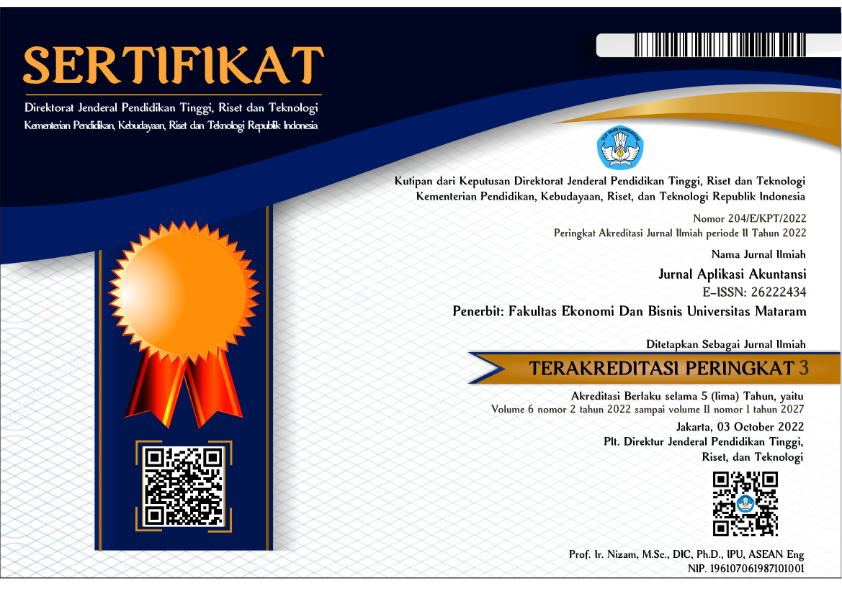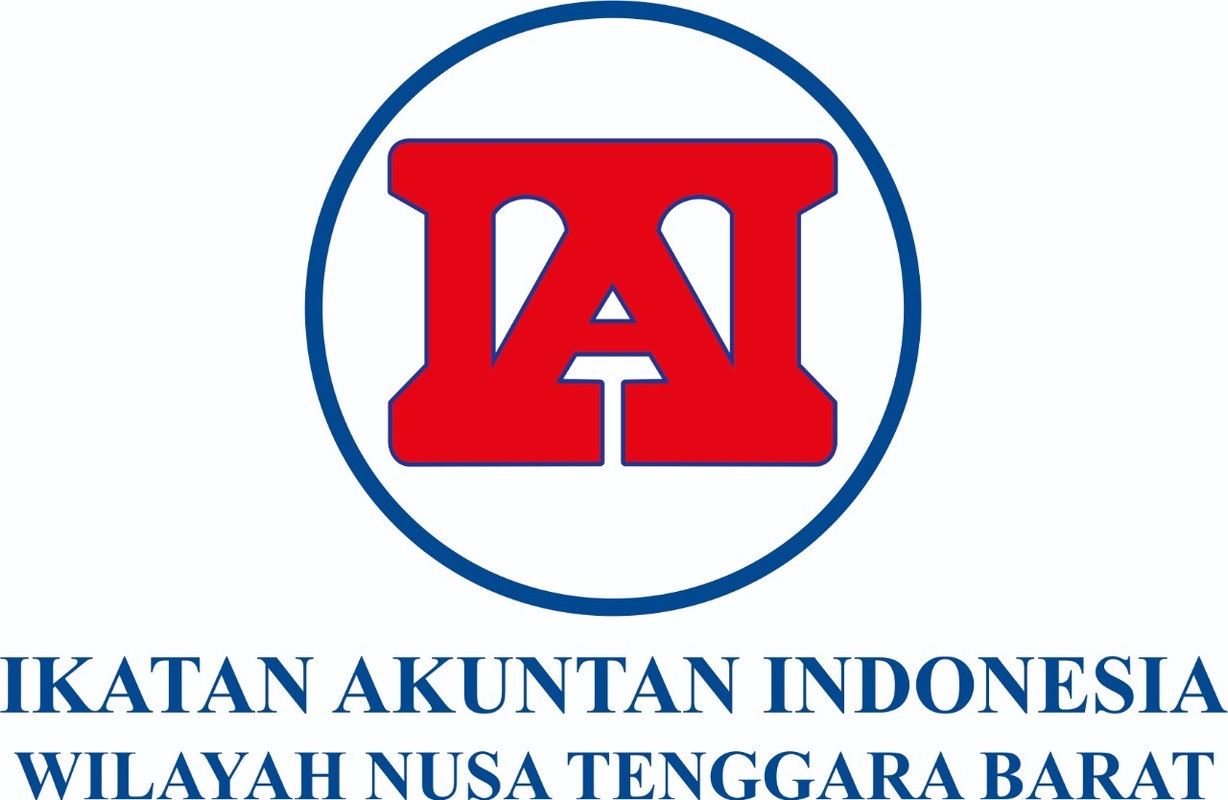THE IMPACT OF GREEN FINANCE ON BANKING PERFORMANCE IN INDONESIA
DOI:
https://doi.org/10.29303/jaa.v9i1.464Keywords:
Green Finance, Return On Asset, Capital Adequacy, Cost Efficiency, Bad LoanAbstract
Green Finance refers to financial practices that can be described through financial services and products that take environmental sustainability to support sustainable development. The role of green finance is to connect financial goals with the environment to encourage inclusive economic growth. One form of green finance implementation is in financial institutions, especially banking. This study aims to analyze the impact of green finance implementation in the banking sector on banking performance as proxied by the profitability ratio in the 2018-2022 period. The Generalized Method of Moments (GMM) dynamic panel is used. The Green Daily Operation (GDO) and Green Finance Policy (GFP) variables indicate the implementation of green finance in banking. Other independent variables use banking performance ratios consisting of the capital adequacy ratio, non-performing loans, and the bank's operational efficiency ratio. The study results show that green finance represented by implementing GFP can increase profitability, while GDO does not significantly affect banks' profitability in Indonesia. Furthermore, the internal banking ratio that is not significant to profitability is the capital adequacy ratio, while increasing non-performing loans and operational efficiency ratio significantly negatively impacts bank performance because it reduces profitability. This research supports applying the green concept in the banking sector to improve sustainable bank performance.
References
Anggraini, D., Aryani, D. N., & Prasetyo, I. B. (2020). Analisis Implementasi Green Banking Dan Kinerja Keuangan Terhadap Profitabilitas. Jurnal Bisnis, Manajemen an Infromatika, 17(2), 141–161. https://doi.org/http://dx.doi.org/10.26487/jbmi.v17i2.11264
Birzhanova, A., & Nurgaliyeva, A. (2023). The impact of Green practices on Banks' profitability. ECONOMIC Series of the Bulletin of L.N. Gumilyov ENU, 1, 285–294. https://doi.org/10.32523/2789-4320-2023-1-285-294
Briando, L., Inggriani, E., & Stanley, W. (2021). ANALISIS RASIO LIKUIDITAS, SOLVABILITAS, AKTIVITAS DAN PROFITABILITAS UNTUK MENILAI KINERJA KEUANGAN PADA PT. TANTO INTIM LINE.
Bukhari, S. A. A., Hashim, F., & Amran, A. (2020). The Journey of Pakistan's Banking Industry Towards Green Banking Adoption. South Asian Journal of Business and Management Cases, 9(2), 208–218. https://doi.org/10.1177/2277977920905306
Campiglio, E. (2016). Beyond carbon pricing: The role of banking and monetary policy in financing the transition to a low-carbon economy. Ecological Economics, 121, 220–230. https://doi.org/10.1016/j.ecolecon.2015.03.020
Darmawan, M. W., Sutisna, E., & Suhara, E. (2023). The Influence of Capital Adequacy Ratio (CAR), Loan to Deposit Ratio (LDR) and Operational Costs of Operational Income (BOPO) On Profitability at PT. Bank Negara Indonesia (Persero) Tbk. International Journal of Social Science and Human Research, 06(06). https://doi.org/10.47191/ijsshr/v6-i6-82
Daromes, F. E., Ng, S., & Wijaya, N. (2020). Carbon Emissions Disclosure as Mechanism to Increase Environmental Performance and Control of Idiosyncratic Risk: How They Impact Firm Value. Indonesian Journal of Sustainability Accounting and Management, 4(2), 227. https://doi.org/10.28992/ijsam.v4i2.299
Dave, R. (2024). Green Banking: Fostering Sustainability With Responsible Finance. Futuristic Trends in Management, 3, 209–216. https://doi.org/10.58532/v3bhma4p6ch1
Dewi, A. S. (2017). Pengaruh CAR, BOPO, NPL, NIM, dan LDR terhadap ROA pada Perusahaan di Sektor Perbankan yang Terdaftar di BEI Periode 2012-2016. Jurnal Pundi, 1(3). https://doi.org/10.31575/jp.v1i3.55
Falcone, P. M. (2020). Environmental regulation and green investments: the role of green finance. International Journal of Green Economics, 14(2), 159. https://doi.org/10.1504/IJGE.2020.109735
Fikri, A. F., & Arifin, Z. (2024). The impact of green credit distribution on bank performance and influencing factors. International Journal of Research in Business and Social Science, 13(1), 323–332. https://doi.org/10.20525/ijrbs.v13i1.3185
Firmansyah, M. (2022). Konsep Turunan Green economy dan Penerapannya: Sebuah Analisis Literatur. Ecoplan, 5(2), 141–149. https://doi.org/10.20527/ecoplan.v5i2.543
Grebmer, C., & Diefenbach, S. (2020). The challenges of green marketing communication: Effective communication to environmentally conscious but skeptical consumers. Designs, 4(3), 1–16. https://doi.org/10.3390/designs4030025
Han, H., Al-Ansi, A., Chi, X., Baek, H., & Lee, K. S. (2020). Impact of environmental CSR, service quality, emotional attachment, and price perception on word-of-mouth for full-service airlines. Sustainability (Switzerland), 12(10). https://doi.org/10.3390/SU12103974
Handayani, T., Abubakar, L., & Sukmadilaga, C. (2020). Green Loan Banks Policy To Provide Environment Friendly Project. Diponegoro Law Review, 5(2), 215–230. https://doi.org/10.14710/dilrev.5.2.2020.215-230
Hartiwi, L. I. A. I. (2023). Pengaruh NPL dan BOPO Terhadap Profitabilitas Pada Bank Umum Konvensional Pada Masa Pandemi Covid 19. Jurnal Akuntansi, Ekonomi Dan Manajemen Bisnis, 3(2), 237–243. https://doi.org/10.55606/jaemb.v3i2.1694
Hasanah, N., & Hariyono, S. (2022). Analisis Implementasi Green Financing Dan Kinerja Keuangan Terhadap Profitabilitas Perbankan Umum Di Indonesia. Jurnal Ekobis : Ekonomi Bisnis & Manajemen, 12(1), 149–157. https://doi.org/10.37932/j.e.v12i1.444
Hishamuddin, M. R. A., Bujang, I., & Rimin, F. (2024, May 6). Transformative Impacts of Green Finance on Co2 Emissions and Bank Stability. The European Proceedings of Social and Behavioural Sciences. https://doi.org/10.15405/epsbs.2024.05.30
Höhne, N., Fekete, H., den Elzen, M. G. J., Hof, A. F., & Kuramochi, T. (2018). Assessing the ambition of post-2020 climate targets: a comprehensive framework. Climate Policy, 18(4), 425–441. https://doi.org/10.1080/14693062.2017.1294046
Jain, P., & Sharma, B. K. (2023). Impact of Green Banking Practices on Sustainable Environmental Performance and Profitability of Private Sector Banks. International Journal of Social Ecology and Sustainable Development, 14(1), 1–19. https://doi.org/10.4018/IJSESD.330135
Kapoor, N., Jaitly, M., & Gupta, R. (2016). Green Banking: A step towards Sustainable Development. In International Journal of Research in Management. www.indusedu.org
Kasztelan, A. (2017). Green Growth, Green Economy and Sustainable Development: Terminological and Relational Discourse. Prague Economic Papers, 26(4), 487–499. https://doi.org/10.18267/j.pep.626
Knebel, S., & Seele, P. (2020). Introducing public procurement tenders as part of corporate communications: a typological analysis based on CSR reporting indicators. Corporate Communications, 26(3), 484–500. https://doi.org/10.1108/CCIJ-01-2020-0029
Kumar, J., Rani, G., Ranii, M., & Rani, V. (2024). Do green banking practices improve the sustainability performance of banking institutions? The mediating role of green finance. Social Responsibility Journal. https://doi.org/10.1108/srj-02-2024-0096
Laskowska, A. (2018). Green banking as the prospective dimension of banking in Poland. Ecological Questions, 29(1), 129–135. https://doi.org/10.12775/EQ.2018.011
Lestari, T., Andini, R., Raharjo, K., & Si, M. (2015). Dampak Rasio CAR, NPL, NPM, ROA, LDR, IRR dan Ukuran Perusahaan.
Lin, W.-L., Cheah, J.-H., Azali, M., Ho, J. A., & Yip, N. (2019). Does firm size matter? Evidence on the impact of the green innovation strategy on corporate financial performance in the automotive sector. Journal of Cleaner Production, 229, 974–988. https://doi.org/10.1016/j.jclepro.2019.04.214
Maulana, Y., Harjadi, D., & Lismawati, L. (2023). Pengaruh Kredit Bermasalah dan Penyaluran Kredit Terhadap Profitabilitas Bank BUMN Terdaftar BEI. Equilibrium: Jurnal Penelitian Pendidikan Dan Ekonomi, 20(01), 55–61. https://doi.org/10.25134/equi.v20i01.6759
N. V. Kavitha and Usha Rani. (2016). Green Banking-towards Sustainable Development. www.ijird.com
Nguyen, T. Van, Bui, H. T. T., & Le, C. H. D. (2022). The impacts of corporate social responsibility to corporate financial performance: A case study of Vietnamese commercial banks. Cogent Economics & Finance, 10(1). https://doi.org/10.1080/23322039.2022.2132642
Nurzaman, W., & Fatihah, D. C. (2022). Pengaruh Resiko Kredit Macet Terhadap Profitabilitas Pada PT. Adira Multifinance. EKBIS (Ekonomi & Bisnis), 9(1), 95–104. https://doi.org/10.56689/ekbis.v9i1.890
Park, H., & Kim, J. D. (2020). Transition towards green banking: role of financial regulators and financial institutions. Asian Journal of Sustainability and Social Responsibility, 5(1). https://doi.org/10.1186/s41180-020-00034-3
Pasha, R., & Elbages, B. (2022). Green banking practices: The impact of internet banking on bank profitability in Egypt. Corporate and Business Strategy Review, 3(2), 65–75. https://doi.org/10.22495/cbsrv3i2art6
Pinasti, W. F., & Mustikawati, RR. I. (2018). Pengaruh CAR, BOPO, NPL, NIM dan LDR Terhadap Profitabilitas Bank Umum Periode 2011-2015. Nominal, Barometer Riset Akuntansi Dan Manajemen, 7(1). https://doi.org/10.21831/nominal.v7i1.19365
Priharta, A., & Gani, N. A. (2023). Determinants of bank profitability: Empirical evidence from Republic of Indonesia state-owned banks. Contaduría y Administración, 69(3). https://doi.org/10.22201/fca.24488410e.2024.4999
Priyanto, D., Raharjo, A., Setiaji, B., & Syamsudin, D. (2014). PENGARUH RASIO CAR, NPL, LDR, BOPO, DAN NIM TERHADAP KINERJA BANK UMUM DI INDONESIA.
Putri, A. E., & Zuhroh, I. (2024). Investigating the Impact of Green Banking Disclosure, Profitability, Company Size, and Non-Performing Loans on Company Value. E-Jurnal Akuntansi, 34(5). https://doi.org/10.24843/EJA.2024.v34.i05.p04
Putri, C. A., Fasa, M. I., Suharto, S., & Fachri, A. (2023). Inovasi Green Banking pada Layanan Perbankan Syari’ah. Mutanaqishah: Journal of Islamic Banking, 2(2), 69–79. https://doi.org/10.54045/mutanaqishah.v2i2.402
Ramadhany, A. A., Fadlilah, A. H., Richmayati, M., Mustika, I., & Nabella, S. D. (2021a). The Mediation Effect Firm Performance on Green Innovation and Firm Value: Evidence the Mining Industry. International Journal of Science, Engineering and Management (IJSEM), 6(3). https://doi.org/10.17762/turcomat.v12i3.909
Ramadhany, A. A., Fadlilah, A. H., Richmayati, M., Mustika, I., & Nabella, S. D. (2021b). The Mediation Effect Firm Performance on Green Innovation and Firm Value: Evidence the Mining Industry. In Turkish Journal of Computer and Mathematics Education (Vol. 12, Issue 3). www.idx.go.id.
Ramila, M., & Gurusamy, S. (2015). Impact of Green Banking Initiatives on Banks' Profitability A Comparative Study of Public, Private and Foreign Banks. Commerce Spectrum, 3(1).
Ratnasari, T., Surwanti, A., & Pribadi, F. (2021, March 1). Implementation of Green Banking and Financial Performance on Commercial Banks in Indonesia. Recent Developments in Asian Economics International Symposia in Economic Theory and Econometrics. https://doi.org/10.1108/S1571-038620210000028018
Raza, A., Saeed, A., Iqbal, M. K., Saeed, U., Sadiq, I., & Faraz, N. A. (2020). Linking corporate social responsibility to customer loyalty through co-creation and customer company identification: Exploring sequential mediation mechanism. Sustainability (Switzerland), 12(6). https://doi.org/10.3390/su12062525
Shaheen, L., & Zaytoun, A. (2024). Examining the Impact of Social Disclosures on the Profitability of Jordanian Commercial Banks: A Comprehensive Study. Wseas Transactions On Business And Economics, 21, 1383–1391. https://doi.org/10.37394/23207.2024.21.113
Shaumya, K., & Arulrajah, A. A. (2016). Measuring Green Banking Practices: Evidence from Sri Lanka. 13th International Conference on Business Management.
Shershneva, E. G., & Kondyukova, E. S. (2020). Green Banking as a Progressive Format of Financial Activity in Transition to Sustainable Economy. IOP Conference Series: Materials Science and Engineering, 753(7), 072003. https://doi.org/10.1088/1757-899X/753/7/072003
Sholikudin, M., & Hwihanus, H. (2024). Is Bank Financial Performance Affected By Corporate Social Responsibility? A Meta-Analysis. Jurnal Riset Akuntansi, 2(3), 53–63. https://doi.org/10.54066/jura-itb.v2i3.2074
Sohn, J., Lee, J., & Kim, N. (2020). Going green inside and out: Corporate environmental responsibility and financial performance under regulatory stringency. Sustainability (Switzerland), 12(9). https://doi.org/10.3390/su12093850
Sudarno, S., Suyono, S., Yusrizal, Y., & Tambunan, J. (2021). Determinant Models Affecting Financial Performance and Stock Return Companies Registered in Indonesia Stock Exchange. Jurnal Aplikasi Manajemen, 19(4), 905–924. https://doi.org/10.21776/ub.jam.2021.019.04.18
Suprayogi, M. A. (2023). Analisis Data Panel Dinamis Pertumbuhan Ekonomi di Indonesia Dengan Metode FD-GMM dan SYS-GMM. Jurnal Bayesian: Jurnal Ilmiah Statistika Dan Ekonometrika, 3(1), 38–47.
Sutisna, E., Ameliana, Y., & Sutisman, E. (2023). Strategi Penyelesaian Kredit Macet dan Dampak terhadap Kinerja Keuangan pada PT Bank BPD Papua Jayapura. Prosiding Seminar Nasional Forum Manajemen Indonesia - e-ISSN 3026-4499, 1, 461–470. https://doi.org/10.47747/snfmi.v1i.1521
Swandriya, S., Indarto, I., & Budiati, Y. (2024). Analisis Pengaruh Biaya Operasional Pendapatan Operasional, Net Interest Margin , Loan to Deposit Ratio Terhadap Profitabilitas. Sustainable Business Journal, 3(1), 35. https://doi.org/10.26623/sbj.v3i1.9536
Taşkın, D. (2015). Special Issue on Social Responsibility Education and Practices The Relationship between CSR and Banks' Financial Performance: Evidence from Turkey Kurumsal Sosyal Sorumluluk ve Bankaların Finansal Performansları Arasındaki İlişki: Türkiye'den Kanıtlar. Social Responsibility Education and Practices, 21–30. https://doi.org/https://doi.org/10.19168/jyu.97694
Uddin, M. N. (2016). "Shari'ah" Based Banking and Green Financing: Evidence from Bangladesh. https://doi.org/DOI:10.24191/jeeir.v4i2.9088
Widjaja, A., Kusuma, T. C., & Tobing, G. L. (2023). Tinjauan Yuridis Penyelesaian Kredit Macet terhadap Profitabilitas Bank. Syntax Literate ; Jurnal Ilmiah Indonesia, 8(9), 6110–6121. https://doi.org/10.36418/syntax-literate.v8i9.13831
Xie, X., Huo, J., & Zou, H. (2019). Green process innovation, green product innovation, and corporate financial performance: A content analysis method. Journal of Business Research, 101, 697–706. https://doi.org/10.1016/j.jbusres.2019.01.010
Yang, L. (2024). Analysis of Developing Commercial Bank Green Finance Programs. Highlights in Business, Economics and Management, 24, 1710–1719. https://doi.org/10.54097/t3hd1k23
Zhang, F., & Zhang, S. (2024). The Impact of Green Finance on the Profitability of Commercial Banks. Frontiers in Business, Economics and Management, 15(3), 136–138. https://doi.org/10.54097/9geb4k46
Downloads
Published
How to Cite
Issue
Section
License
Copyright (c) 2024 Rafly Izaz Mada Yafie, Idah Zuhroh, Firdha Aksari Anindyntha

This work is licensed under a Creative Commons Attribution-NonCommercial-ShareAlike 4.0 International License.









